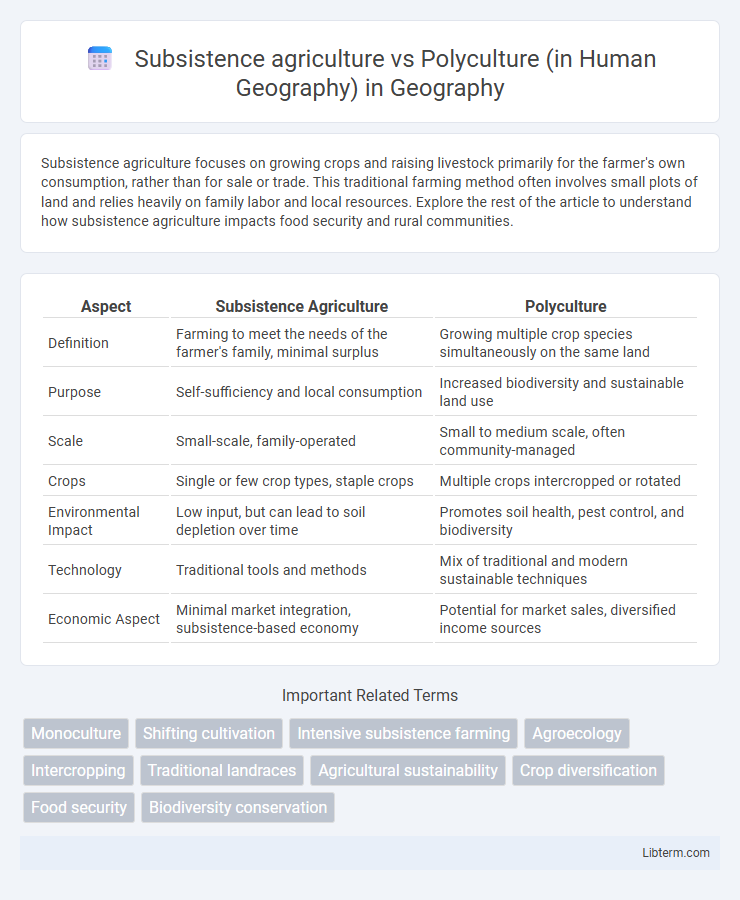Subsistence agriculture focuses on growing crops and raising livestock primarily for the farmer's own consumption, rather than for sale or trade. This traditional farming method often involves small plots of land and relies heavily on family labor and local resources. Explore the rest of the article to understand how subsistence agriculture impacts food security and rural communities.
Table of Comparison
| Aspect | Subsistence Agriculture | Polyculture |
|---|---|---|
| Definition | Farming to meet the needs of the farmer's family, minimal surplus | Growing multiple crop species simultaneously on the same land |
| Purpose | Self-sufficiency and local consumption | Increased biodiversity and sustainable land use |
| Scale | Small-scale, family-operated | Small to medium scale, often community-managed |
| Crops | Single or few crop types, staple crops | Multiple crops intercropped or rotated |
| Environmental Impact | Low input, but can lead to soil depletion over time | Promotes soil health, pest control, and biodiversity |
| Technology | Traditional tools and methods | Mix of traditional and modern sustainable techniques |
| Economic Aspect | Minimal market integration, subsistence-based economy | Potential for market sales, diversified income sources |
Introduction to Subsistence Agriculture and Polyculture
Subsistence agriculture involves small-scale farming aimed at self-sufficiency, where farmers grow crops and rear animals primarily for local consumption rather than for sale. Polyculture refers to the agricultural practice of cultivating multiple crop species simultaneously in the same space to enhance biodiversity, improve soil health, and reduce pest outbreaks. Both methods are integral to traditional farming systems in many developing regions, supporting sustainable livelihoods and food security.
Definitions and Key Concepts
Subsistence agriculture involves farmers growing food primarily to feed themselves and their families, relying on traditional methods and minimal technology, which limits surplus production. Polyculture is the practice of cultivating multiple crop species simultaneously on the same land, enhancing biodiversity, soil health, and resilience against pests compared to monoculture systems. Both subsistence agriculture and polyculture emphasize sustainability and local food security but differ in scale and crop diversity strategies.
Historical Context of Subsistence Agriculture
Subsistence agriculture, rooted in early human societies, traditionally involves small-scale farming aimed at self-sufficiency, where crops and livestock are primarily grown for household consumption rather than market sale. Historically, subsistence farming shaped rural landscapes and social structures, influencing population distribution and land use patterns before industrial agriculture emerged. Polyculture, often practiced within subsistence systems, contrasts with monoculture by cultivating multiple crop species simultaneously, enhancing biodiversity and sustainability in historical agrarian communities.
Evolution and Practices of Polyculture
Polyculture in human geography evolved as an advanced form of subsistence agriculture, enhancing biodiversity and soil fertility through the simultaneous cultivation of multiple crop species. This practice contrasts with monoculture by reducing pest outbreaks and improving resilience to climatic variations, supporting sustainable livelihoods in diverse ecological zones. Modern polyculture integrates traditional knowledge with agroecological innovations, promoting food security and environmental conservation in smallholder farming systems.
Geographic Distribution and Regional Examples
Subsistence agriculture predominates in regions such as Sub-Saharan Africa, South Asia, and parts of Latin America, where small-scale farming supports local communities with minimal market surplus. Polyculture is widely practiced in Southeast Asia, including Indonesia and the Philippines, leveraging diverse crops like rice, vegetables, and fish to enhance food security and ecological sustainability. Geographic factors such as climate, soil fertility, and population density influence the dominance of subsistence farming in less developed rural areas versus polyculture systems in more biodiverse, tropical environments.
Environmental Impacts: Monoculture vs Polyculture
Monoculture in subsistence agriculture leads to soil degradation, increased vulnerability to pests, and loss of biodiversity due to the continuous cultivation of a single crop species. Polyculture, by contrast, promotes environmental sustainability through enhanced soil fertility, natural pest control, and greater ecosystem resilience by integrating multiple crop varieties. The diverse plant interactions in polyculture systems reduce chemical input dependency and improve habitat complexity, supporting long-term agricultural productivity and ecological balance.
Socio-Economic Implications for Rural Communities
Subsistence agriculture, characterized by small-scale farming primarily for local consumption, often limits rural communities' access to broader markets and economic growth, reinforcing poverty cycles and food insecurity. Polyculture, which integrates multiple crop species, enhances biodiversity, soil fertility, and resilience against pests, supporting sustainable livelihoods and improving nutrition in rural areas. The diversification from polyculture promotes economic stability by enabling surplus production for trade, increasing income and community development opportunities.
Food Security and Sustainability Perspectives
Subsistence agriculture primarily supports local food security by producing food mainly for the farmer's family, limiting surplus for broader distribution, whereas polyculture enhances sustainability by cultivating multiple crops simultaneously, improving soil health and reducing pest outbreaks. Polyculture's biodiversity increases resilience to climate variability, promoting long-term food security compared to the mono-crop dependency common in subsistence farming. Food security improves when polyculture practices are integrated into subsistence agriculture, optimizing resource use and minimizing environmental degradation.
Challenges and Limitations of Each System
Subsistence agriculture faces challenges such as low productivity, vulnerability to climate variability, and limited access to modern technology, which restricts food security and economic growth. Polyculture offers biodiversity benefits and pest resistance but encounters limitations including labor intensity, difficulties in mechanization, and complex management of multiple crops. Both systems struggle with scalability, market integration, and adapting to rapidly changing environmental conditions.
Future Trends and Policy Considerations
Subsistence agriculture, characterized by small-scale farming for local consumption, faces challenges from climate change and land degradation, prompting shifts toward sustainable practices and diversification. Polyculture systems, which integrate multiple crops and livestock, enhance biodiversity and resilience, showing promising potential for food security in the context of global environmental stresses. Policy considerations increasingly emphasize supporting agroecological methods, investing in farmer education, and incentivizing sustainable land management to balance productivity with ecological preservation.
Subsistence agriculture Infographic

 libterm.com
libterm.com